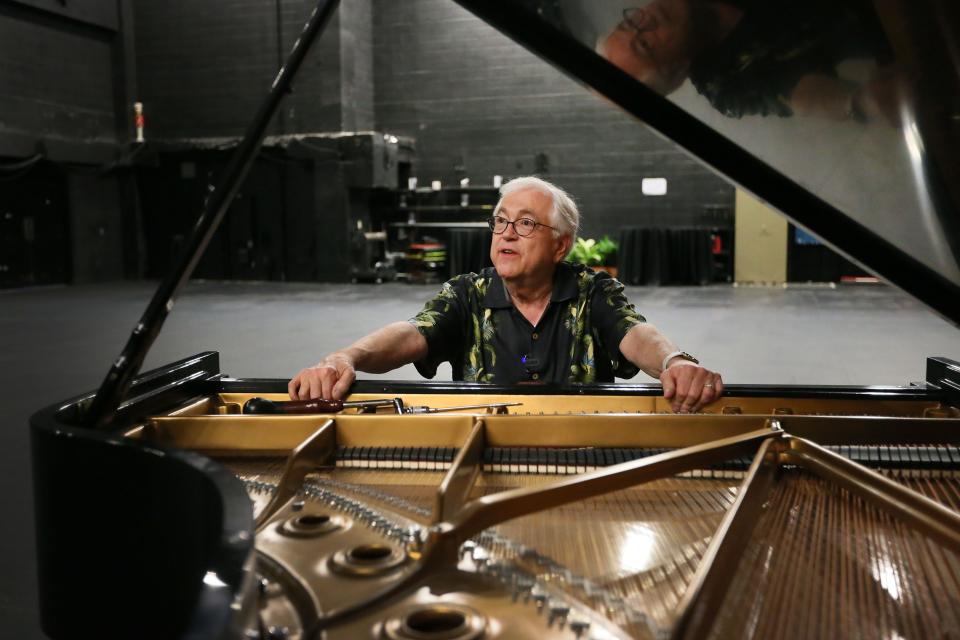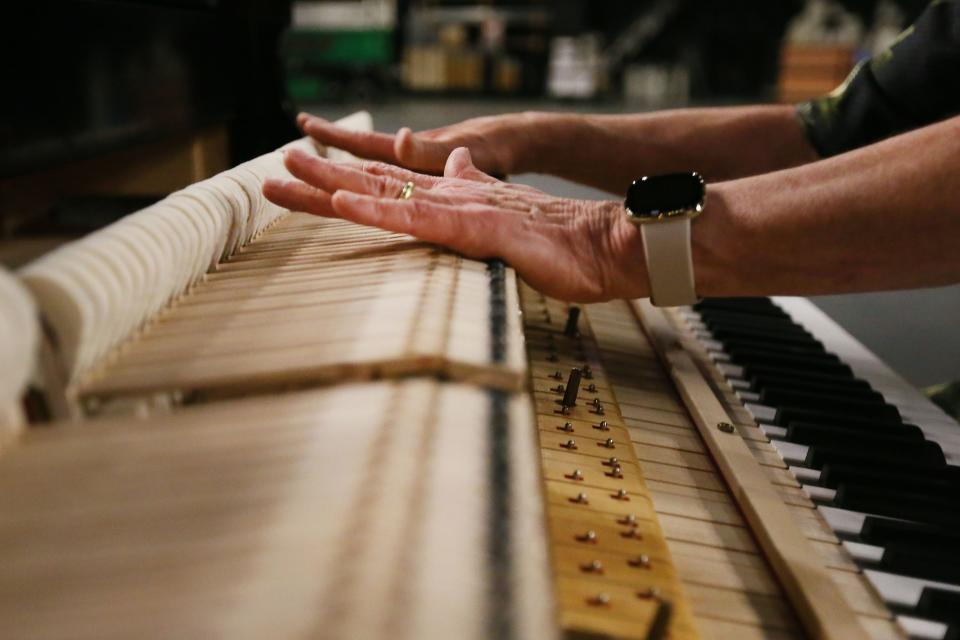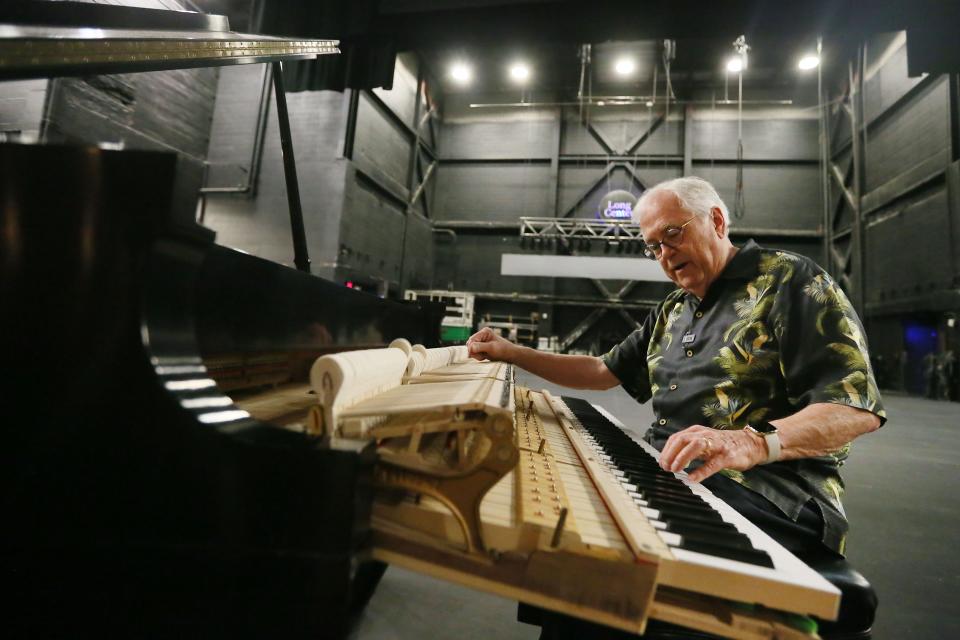‘Anything can happen': Wit and wisdom from one of Austin’s best piano tuners
Stare at the innards of a piano — especially a concert grand — and you begin to understand why the folks who tune these elegant monsters are often called "piano technicians."
A more appropriate term might be "piano engineers."
From the audience, one can see the 88 white and black keys on the keyboard, which the pianist sets into motion with the touch of long-practiced fingers.
Under the curved lid, however, are a dizzying array of pins, dampers, hammers, a soundboard, an action frame, tuning pins, treble bridge and strings, bass bridge and strings, and a cast iron plate.
Since he was a mere youth, Charles Ball, always curious about the way things work, has tuned — or tamed — these emperors of musical instruments.
For the past 40 years, Ball has adjusted the concert grand pianos for the Austin Symphony Orchestra, while at the same time leading a team of four tuners at the University of Texas Butler School of Music. That UT team keeps more than 200 practice and performance pianos in top shape.
More:Explore the historically upside-down world of dance marathons in Depression-era Galveston
Ball retired from UT in 2019, and from the symphony — for which he worked pro bono during recent seasons — earlier this year.
Along the way, Ball has befriended some of the greatest pianists in the world.
"I have to admit I was starstruck at first," says Ball, whose cursive speech is interrupted by tuneful laughter. "The ones who tour regularly always treat you well. They have the least complaints. The pianists who play infrequently, however, need a bit more care and support."
'Like taking a correspondence course in gall bladder surgery'
Charles Ball, 72, grew up in Maryville, Tennessee, about half an hour south of Knoxville. When he was young, his mother bought an old upright piano.
"Right away, I just started taking it apart," he says. "It all seemed very familiar to me. Then I hung around the piano repair shop and the piano dealership. Finally, I took a correspondence course in piano tuning, which is rather like taking a correspondence course in gall bladder surgery."
For a while, he worked at the University of Tennessee — "the other UT" — as he calls it. Ball arrived in Austin in May 1980 just as UT Austin was completing what was then known as the College of Fine Arts Performing Arts Center, or, inelegantly, COFAPAC.
More:For half a century, Texans have studied Shakespeare by performing his plays in a barn
That imposing brick complex includes Bass Concert Hall, McCullough Theatre and Bates Recital Hall with its enormous tracker-action organ. Together, the three venues are home to hundreds of recitals and other performances every season.
"A friend and collaborative pianist at UT Knoxville urged me to apply at UT Austin as piano technician," Ball recalls. "He said: 'They have oodles of money and a fabulous new building.'"
Meanwhile, what became known at the Butler School of Music systematically hired more faculty in applied piano (performance) — some of those have since retired — piano pedagogy (teaching methods) and collaborative piano (the updated term for what an accompanist does).
As team leader, he concentrated on the concert instruments and those in key faculty studios, while others on his team cared for the bulk of the inventory, including the practice room pianos.
"I'd do one or two full tunings a day," Ball says. "The others might do three or four."

In 1981, the Austin Symphony moved from the old Palmer Auditorium on the south shore of the lake to UT's Bass Concert Hall. Neither of those big, roomy halls was kind to the local ensemble's instrumentalists.
In 2008, however, when the symphony moved into the smaller, carefully designed Dell Hall at the Long Center for the Performing Arts — a much more suitable venue for this musical group — Ball found that its concert pianos required different adjustments.
"I changed the way I 'voiced' them," he says. "Dell Hall needs more bass support, but the soprano tones are very clear."
When the Long Center — a complete remaking of the old Palmer Auditorium that included superb acoustics — neared its opening, Ball was part of a piano selection group that included Austin's globe-trotting concert pianist Anton Nel. They were charged with picking two grands, one 9-foot long, the other 7-foot long, on a budget.
"Anton and I were in complete agreement about choosing the 9-foot Hamburg Steinway," he says of the renowned piano-making company that manufactures in this country and in Germany. "We purchased it from the Steinway Concert Department in New York. It had been used at the Aspen Festival and Anton knew it well."
More:Ever seen a micro musical? 'Mack & Mabel' proves they can work in Austin
The Long Center's 7-footer was found closer to home.
"We bought a really fine piano that belonged to one of my regular clients, a man in high tech who also played very well," Ball says. "He had a salt-water aquarium in the same room, so we had to clean up some of the oxidation on the piano's metal parts."
During the height of concert seasons at both UT and the Long Center, Ball was on standby almost every day.
"There almost had to be at least one problem a night," he says. "Some of them imagined. I'd stay back stage and pace and smoke, back when you could, I was no nervous. Anything can happen. A string can break. Somebody can spill a drink into the piano. That happened twice."

How to tune a grand piano
"Modern piano tuning is not a musical process," Ball says. "It is a scientific one."
Ball explains the three-part process for preparing a piano for performance:
Tuning: Adjusting the tension on the strings.
Regulating: Working on the mechanical actions of the piano, such as how the hammers hit the strings.
Voicing: Controlling the tone of the piano as a whole.
"Some pianists don't even know about 'voicing,'" Ball says. “For instance, we might use a chemical hardener on the hammer felt for more power and brilliance, or stab the felt with needles to tame overly bright or harsh notes.
"Because, unliked most other instruments, there is a complex mechanism that mediates between the player's hand and the source of the sound — the strings — it is crucial that the mechanism also be fine tuned to be responsive to their most subtle touch."
American virtuoso pianist Raymond Lewenthal, who once wore a cape in a commercial album's cover photo and was booked in Austin to play a concerto by Edvard Grieg, walked onstage to find Ball voicing a concert grand.
"What are you doing, young man?" he demanded. After Ball explained, Lewenthal responded, "For me, just make it loud. It must get past the first row!"
More:'Waltz Across Texas' with these great songs about the Lone Star State
Ball never minded the feedback. "Sometimes, however, it was not given in the most gentle way."
Van Cliburn, the Texas phenomenon, was always kind. The Fort Worth-based celebrity was often asked to play in Austin. Once, at a surprise birthday reception given for a Texas governor's wife, Ball waited on standby for two days.
"Van's primary concern was whether the bench had been adjusted as high as possible; that the music rack had been removed; and that the carpet was removed from under the piano," Ball remembers.
Ball went on to maintain the Cliburn Foundation's pianos at Bass Hall in Fort Worth — yes, both cities named halls for the billionaire Bass family — and inside the piano pavilion at the Kimbell Art Museum there.
In September 1998, he tuned pianos for the grand opening of Forth Worth's Bass, which included Cliburn's first solo in some time at the gala, and for his performance of Rachmaninoff Piano Concerto No. 2 in the hall.
"Van passed out at the opening of the last movement and was carried off by EMS before a shocked audience, decked out in gowns, jewels and tuxes" Ball says.

He was also backstage in 2012 after having prepared four concert grand Steinway pianos for four Cliburn Competition gold medalists who played at the gala celebrating the Cliburn Foundation's 50th anniversary.
"Van, who had recently received a cancer diagnosis, arrived unexpectedly backstage in a wheelchair and greeted the audience," Ball remembers. "He lauded the foundation and its history, and concluded, 'God bless America; God bless Texas; and God bless every one of you. I'll love you all forever.' He walked offstage, collapsed in his wheelchair and declared, 'Thank God I'll never have to speak in public again.'"
The most embarrassing moment in Ball's career came when, during a piano selection process, Cliburn asked him to play while the virtuoso listened from the house.
"Pianists have a lot of different tastes," Ball says. "In different ages, pianists have preferred different tuning methods, which favored certain frequently used key signatures. For instance, Bach would tune his instrument to favor the music he was playing or teaching at the moment. Later compositions, however, modulated so freely that all the keys' tonalities needed to be tuned at the same time."
Russian-born Vladimir Ashkenazy, one of the most honored and recorded pianists of the past century, once praised Ball's craft at a post-recital reception held by the UT piano faculty.
Ball: "That raised my stock considerably."
During the final paired concerts of last season, Austin Symphony maestro Peter Bay invited Ball to take an onstage bow.
Ball: "I quipped to him that I prefer working before an empty house."
The symphony season opener Sept. 23-24, which includes Ravel's Piano Concerto in G Major performed by Benedetto Lupo, will mark another debut for Long Center's Steinway — for the past few months, it has been restrung at a workshop in San Marcos.
"It takes a while for the strings to settle in and hold the pitch," Balls says. "The strings are elastic when new. In a concert grand, they handle 30 tons of tension."
In retirement, Ball still freelances a bit.
"Maybe two or four a week," Ball jokes, "to fund my extravagant lifestyle."
Michael Barnes writes about the people, places, culture and history of Austin and Texas. He can be reached at mbarnes@statesman.com.
Austin Symphony Orchestra 2022-23 season highlights
The Austin Symphony Orchestra's season revs up Sept. 23-24 at the Long Center for the Performing Arts. More information and tickets: austinsymphony.org, 512-476-6064.
Some composers or performers highlighted during the season:
Sept. 23-24: Ravel, Tchaikovsky
Oct. 1: Judy Garland Tribute
Oct. 21-22: Brahms
Nov. 18-19: Mendelssohn
Jan. 13-14: Fauré
Feb. 17-18: Rachmaninoff
March 24-25: Mahler
April 6: Brahms X Radiohead
April 14-15: Beethoven, Rodrigo
May 19-20: Rimsky-Korsakov, Gang & Zhanhoa
This article originally appeared on Austin American-Statesman: Piano tuning Austin: Meet the man who kept symphony, UT in good note

